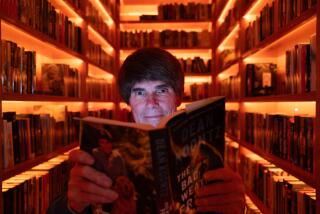A Novelist Who Knows His Business
- Share via
NEWPORT BEACH — As a struggling young novelist in the late 1960s and early ‘70s,Dean Koontz cranked out an average of four books a year, many of them paperback originals and most written under a variety of pen names in a variety of genres.
At only $1,500 to $2,500 a pop, the former Pennsylvania English teacher needed to be prolific.
But a funny thing happened to Koontz on the way to his multimillion-dollar manse in Newport Beach: The books he wrote two decades ago have come home to roost. Big time.
Banking on his future even when he was a poorly paid unknown, Koontz wisely retained--or bought back--the rights to his books once they went out of print.
In 1989, he sold a block of seven of his old titles to Berkley for about $3.5 million. But the big payoff came three years later, when Ballantine Books purchased the paperback rights to seven more from the ‘70s for about $10 million.
Ballantine, which is releasing one old Koontz title a year, last month published the latest, “Icebound,” an adventure-suspense novel originally titled “Prison of Ice” when Lippincott published it in hardcover in 1976 under the Koontz pen name David Axton.
“Icebound,” which was given a whopping 2 million first printing, skyrocketed directly to the No. 1 spot on the New York Times paperback bestseller list after only a week in bookstores.
Koontz’s enviable position of being able to reap the financial benefits of novels he wrote two decades ago underscores his reputation as a best-selling novelist who is also a savvy businessman.
“He’s managed his career well,” said Clare Ferraro, editor in chief of Ballantine. “He always had his eye on the long haul because he realized if he were successful someday, those back-list titles would be worth a great deal more.”
*
With the help of several mentors in publishing, Koontz learned early on to take control of the business side of his writing career.
“Most writers hate the idea of having to be involved in business,” said Koontz, 49. “They want to see themselves solely as artists, and they want somebody else to take care of business, usually an agent.
“The reality is there’re very few really fine agents, so if you don’t learn about the business of publishing and understand the economics of how it works, you become a victim, and you can’t protect your art that way.”
It’s the very nature of Koontz’s long-simmering literary career--combined with his ability to see the potential value of his early works--that has put him in the position he is in today.
Some best-selling authors, such as Scott Turow and John Grisham, sweep to the bestseller lists overnight without accumulating a large back list of out-of-print titles from their apprenticeship days.
Koontz’s career, however, built slowly, his literary craft improving as he gradually built up a large body of work and more readers.
But even in the early days, Koontz said, he was always diligent about regaining the rights to his books when they went out of print.
In some cases his contract included a clause in which the rights to the book reverted to him in a certain number of years, or, when the book went out of print, all he had to do was write a letter claiming the rights.
“I would always watch that and I would always do it,” he said, noting that some other writers would do the same.
What makes Koontz unique, however, is that in cases where there was no reversion clause, he would go to the publisher after the book had gone out of print and offer to pay back his advance to repurchase the rights.
Publishers, he said, “snapped at that.” Sometimes they simply gave him back the rights for nothing.
“They didn’t see any value in the books,” he said. “It’s kind of astounding because some of these books now are in their 30th printing in paperback.”
*
When it comes to reprinting his old books, however, Koontz is not willing to simply take the money and run.
He insists on revising many of the early books because he doesn’t think they measure up to his current level of writing, and he doesn’t want to disappoint his fans.
In the case of “Winter Moon”--the first Koontz novel reissued by Ballantine in January, 1994--not a single sentence remains from the original “Invasion,” a Laser paperback published in 1974 under the pen name Aaron Wolfe.
In a note to readers of his latest reissued novel, “Icebound,” Koontz writes that he “revised it and updated the technological and cultural references while trying not to get carried away and alter the entire story line and feel of it.”
Koontz is not the first novelist unable to resist the temptation to revise his early books after achieving success. Sir Walter Scott did it. Henry James was famous for it. More recently John Fowles revised his 1965 novel “The Magus.” And for a 1991 reissue of Stephen King’s “The Stand,” King revised it and reinstated material that had been cut out of the novel when it was originally published in 1978.
But rewriting an old novel for paperback reissue is so unusual that publishing sources have trouble coming up with contemporary counterparts to Koontz.
With more than 60 novels to his credit--42 were published between 1968 and 1980, when he first reached paperback bestseller lists--there are bound to be early works that now fall short in Koontz’s more developed critical estimation.
He concedes that some of his old books, such as many of the science-fiction paperback originals he wrote in the late 1960s, will never see print again.
But in looking over his list a few years ago, he figured there were probably more than 20 out-of-print books that he would consider bringing back. He knew, however, that some would need work.
“Sometimes when you look back at your old books you just wince and say, ‘How could I have written that?’ ” he said, seated in the billiard room of his hilltop home overlooking Newport Beach.
Although he can see the value in a particular early book--”the essence of the story and the characters are there”--Koontz said he didn’t have the skill and sometimes the time to write a better book when he was younger. (He began writing full-time in 1969, at 24.)
But now, “I can run this story through the (computer) again and make it better,” he said.
Revising his early works for paperback reissue has become something of a second career for Koontz, who still manages to turn out one new hardcover suspense novel a year for Knopf. His latest, “Dark Rivers of the Heart,” hit bookstores in November with a 650,000 first printing and rose to No. 7 on the New York Times hardback bestseller list.
Koontz became so enthused about “enhancing” his older books for Ballantine that he decided to “spruce up” the three remaining older titles in the block of seven out-of-print books he sold to Berkley in 1989. “The Key to Midnight,” a 1979 suspense novel he wrote under the pen name Leigh Nichols, will be reissued in April.
The Koontz literary enterprise hums along like a well-oiled engine. Down the hall from his stylishly appointed upstairs office--a dimly lit, book-filled warren that includes copies of his books in 38 languages--are two rooms that serve as offices for what has grown to be a four-person staff.
Gerda, his wife of 28 years, handles the financial side of the business and has served as liaison with foreign literary agents.
Koontz’s staff is in the process of setting up a computer program to keep track of his nearly 1,200 contracts worldwide, alerting them when a license is up and when royalty statements are overdue.
Twelve-hour work days are the norm for Koontz, who has been working seven days a week for the past few years. Up by 6:30 a.m., he’s at his computer at 7:30. He usually works until 5 in the afternoon. He and Gerda go out for a leisurely early dinner, but then he’s usually back at the computer for two more hours.
Koontz insists he is energized by a schedule that would seem to guarantee burnout.
But there’s no question a literary lifetime of long hours has paid off.
Even Koontz said he is surprised by the number of titles he has amassed since he sold his first book in 1968--an Ace paperback science-fiction novel called “Star Quest”--for $1,000.
“You spend 20-some years writing, and you’re working 70- to 80-hour weeks, it’s amazing how things pile up,” he said.
More to Read
Sign up for our Book Club newsletter
Get the latest news, events and more from the Los Angeles Times Book Club, and help us get L.A. reading and talking.
You may occasionally receive promotional content from the Los Angeles Times.








